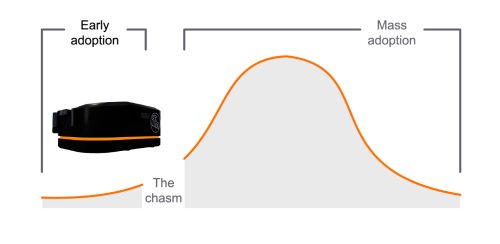- Autonomous mobile robots
- Business challenges
- Mass adoption
The 3 reasons mobile robots haven't reached mass adoption

Automated mobile robotics is the obvious answer to increased consumer demand and continuing labor shortages today. So, why haven’t AMRs “crossed the chasm” into mass adoption?
Or, put even more simply: What aren’t you selling more robots?
We’ve identified three major problem statements that explain these challenges. And, we’ve developed the tools and strategies you need to overcome them.
Three challenges preventing AMR mass adoption
Right now, three primary barriers deter potential customers from adopting mobile robots in their facilities. This is especially true for mid-level companies, but also still for many enterprise-level businesses:
- Lengthy integration process: A customer’s CapEx doesn’t end with the purchase. They also consider programming the fleet and modifying their facility. This integration leads to costly downtime and reduced throughput.
In other words: The longer their integration process, the more expensive your robots are to them. - High BoM Cost: Developing a viable product with a scalable or saleable company model involves significant investment. This expense eventually gets passed to the customer. Then, it exceeds many facilities' budgets, even when a prospect understands your product's value.
- Accidents: Robots still hit things, and potential clients know it. Human safety has been top priority for decades. But, ensuring an AMR doesn’t collide with forklifts or other objects is still a challenge.
The price of a crash isn’t only measured by what it takes to fix damaged equipment. Robot downtime from an unplanned stop costs even more in reduced throughput.
Two ways ifm addresses AMR mass adoption problem statements
ifm understands the startup mindset. You need quick, efficient solutions that work the way you need them to without draining your resources or delaying time to market.
Ultimately an attractive and cost-effective end product means more sales and a more valuable IP.
But the truth is that BoM costs can’t get much lower. Reducing cost by even $1,000 per unit barely makes an impact when a prospect has to consider a seven-figure investment for a fleet.
Instead of only focusing on production costs and market prices, we approached these challenges by:
- Reducing total cost of ownership: Shortening integration time reduces a prospect’s TCO. A fast, cost-effective onboarding may be the deciding factor if your price tag is in their budget.
- Increasing value: What if your robot cost the same as your competitors but could get more work done? Your client wouldn’t need nearly as many units, making your offer more attractive.
Investing in a smaller fleet translates to lower expenses and faster ROI. Yes, you’ll sell less robots to each facility. But, you’ll gain more clients and sell more units overall.
The right sensors and perception products can transform your business
The “secret” to making mobile robots more accessible is your obstacle detection system (ODS):
-
The right ODS increases throughput with fast, accurate decision-making and reduced downtime.
-
You reduce development time and conserve resources with a system that works correctly out of the box and is compatible with your existing components.
-
Industry-standard and open-source programming languages make it easier – and faster – for your end user to get their fleet up and running.
Gain a competitive edge
Ready to learn more about accelerating your robot development?
Fill out our form or contact Tim McCarver directly at tim.mccarver@ifm.com.